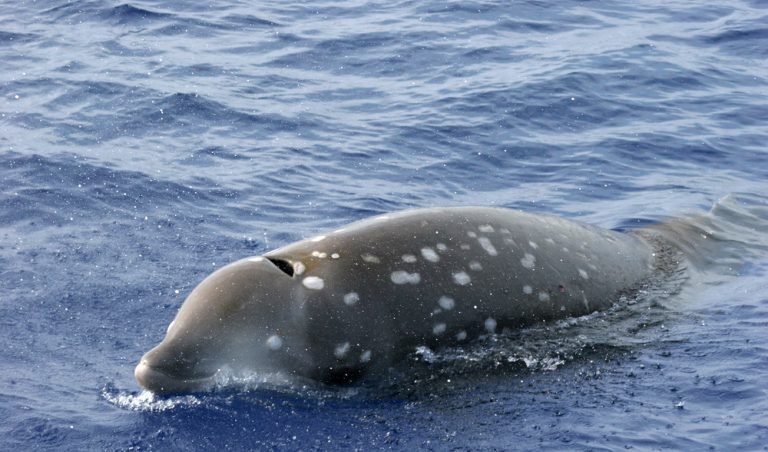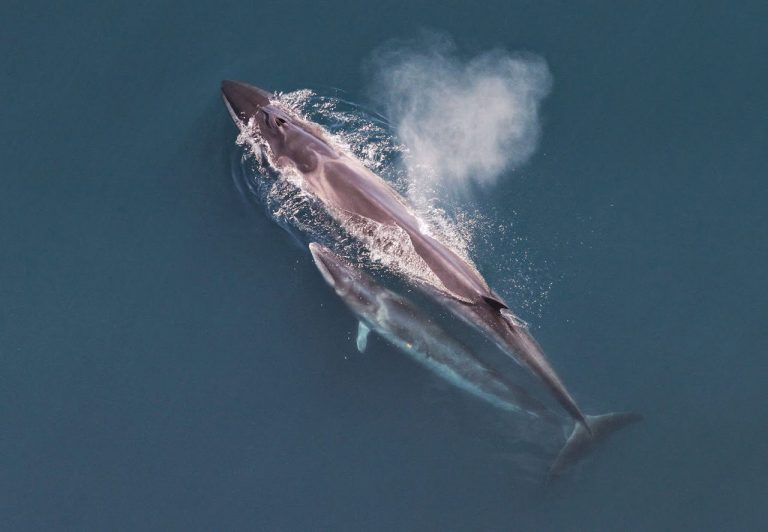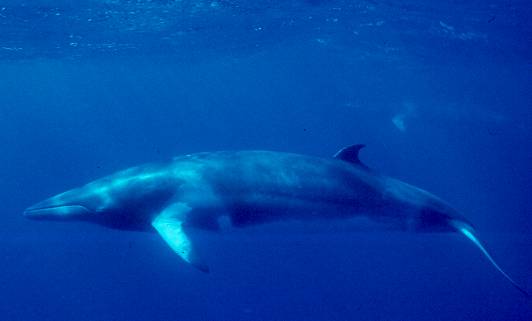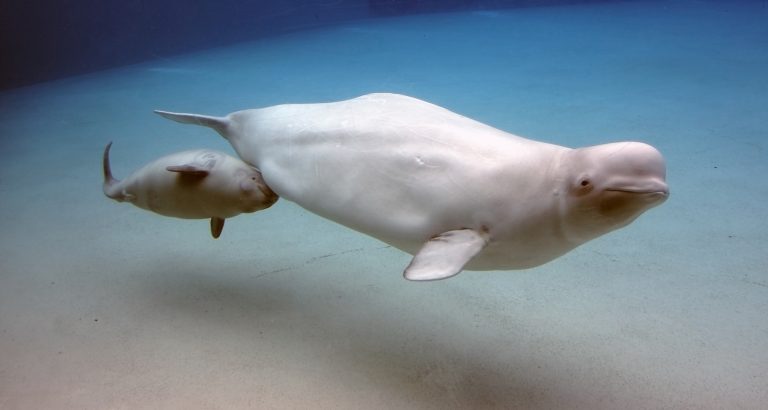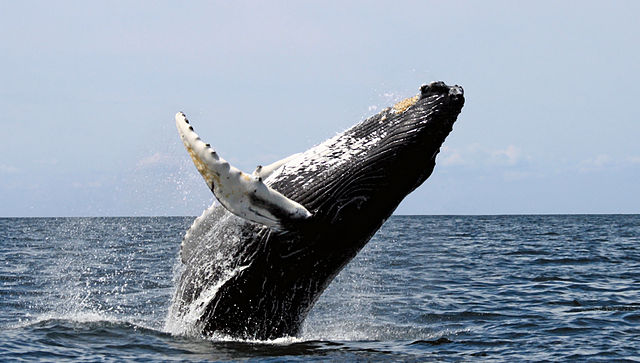Species Profile: The Narwhal
Learn all about the Narwhal. This medium-sized whale has a tooth growing right through its lip.

The Narwhal is a medium-sized toothed whale that belongs to the Monodontidae family. The only other member of this family is the Beluga whale.
Narwhals are easily distinguishable by one unique feature: males of the species, and even a few females, have a large “tusk” that protrudes out of their mouth. In fact, this tusk is an “overgrown” canine tooth that pierces through the left side of their lip.
This spiral-shaped tusk was once touted in past centuries as a unicorn’s horn and sold as such to unsuspecting buyers!
They live mainly in the frigid Arctic waters off the coasts of Greenland, Canada, and Russia all year round. Like most other toothed whales, the Narwhal communicates with its kind using whistles, clicks, and knocks.
These whales are a source of meat and ivory by the Inuit people native to parts of northern Canada and Greenland. They are allowed to hunt limited quantities of narwhals under strict regulations.
The IUCN lists this animal as Near Threatened.
1) Scientific Name
Monodon Monoceros
2) Scientific Classification:
- Kingdom: Animalia
- Phylum: Chordata
- Class: Mammalia
- Order: Artiodactyla
- Family: Cetacea
- Genus: Monodontidae
- Species: Monodon Monoceros
3) Life Expectancy
Narwhals can live for up to 50 years.
4) Average/Maximum Length
On average, the male narwhals are larger than their female counterparts.
An average adult male narwhal ranges between 3.95 and 5.0 meters (13 and 17 feet) in length and they grow to a maximum of 6 meters (20 feet).
Females averagely measure 3.5 meters (11.5 feet) with a maximum length of 5.6 meters (18.5 feet). These lengths exclude the narwhal tusk which averagely measures 2.7 meters (8.8 feet).
5) Average/ Maximum Weight
Owing to the female’s smaller size, they weigh much less than the male narwhals.
An adult narwhal can weigh anything between 1,760 and 3,530 lbs. (800 kg to 1600 kg). Most females weigh about 1760 lbs. (800 kg) while males range from 2,205 lbs. to a maximum of 3,528 lbs. (1000 kg to 1600 kg).
6) Maximum Swimming Speed
Unless escaping from predators, narwhals are generally slow and prefer to stay near the water surface. However, when fleeing from danger, narwhals can dive up to 1,500 meters (5,000 feet) in 25 minutes on average.
7) Interaction With/Danger To Humans
Under normal circumstances, it’s a rare occurrence that a narwhal ever comes close to a human.
Even the greatest scientists admit that it is difficult to come across the narwhals during deep water explorations. This is because narwhals are generally very shy and usually choose to hide in the remotest parts of the oceans.
However, there have been serious issues surrounding humans hunting the narwhal. For instance, natives of the Disko and Hunde Islands (in Greenland depend a lot on whale and narwhal hunting for food. Also, they depend on many of the products from whale parts for survival.
Another serious problem is continuous ocean water pollution by human activities. Oil spills and emptying of sewer lines into the oceans make the ocean an almost uninhabitable place for narwhals and this poses a great risk to their existence.
As a matter of fact, whale enthusiasts express their fear that the narwhal might become extinct if illegal hunting is not controlled.
In addition, the changing climatic conditions that cause lower sea water levels makes it easier for hunters and other predators to see and attack these whales.
8) Reproduction Details
Female narwhals become sexually reproductive at between 4 and 8 years while the males mature at around 8 to 10 years.
It appears that their tusk plays a part in the mating ritual. Narwhals have been seen crossing their tusks when mating. Also, males use their tusks as a weapon during mating to attack and scare off male competitors.
These whales mate between April and May of every year. After a gestation period of about 14 months, their calves are born in late spring or early summer of the following year from June to August.
At birth, a calf measures about 1.5 meters in length. A female narwhal can give birth to one calf every three years.
A calf is nursed by the mother for up to 20 months until it is able to hunt for itself. Before then, calves spend much of their time very close to their mothers.
A narwhal calf feeds on the mother’s fat-rich milk which aids in the thickening of its blubber to guard against the cold weather.
9) Diet/Hunting Pattern Of The Narwhal
Since narwhals have no functional teeth, they suck in and swallow their preys whole without chewing. It is an established fact that the male’s tusk, which is actually an overgrown tooth plays no role at all in feeding. This is because even males and the females with no tusks can feed themselves without any help.
Narwhals have a somewhat specialized diet. A research conducted between June 1978 and September 1979 showed that the Arctic cod and the Greenland halibut were narwhals’ most favorite items of diet at 51 percent and 37 percent respectively. It is a confirmed fact that narwhals also feed on squid, shrimp, and other smaller Arctic fish.
It is interesting to note that during winters, narwhals stay in shallow bays and feed on benthic fish, which are fish that live at the very bottom of the ocean. Here, their diet is much limited. However, in summer they move to the open ocean water where they can now access the cods that they love very much.
Note that since narwhals feed by sucking, they have to be very close to their prey to make the capture possible and easier.
10) Alternative Name
- Narwhale
11) Population And Conservation Status
No one knows the exact population of the narwhal but it is estimated that they could be around 50,000 – 75,000 globally.
Some researchers group the narwhals as nearly extinct, though this if refuted in many quarters. Nevertheless, it is an accepted fact that the narwhal is threatened by the drilling and mining activities that pollute their habitats.
They are most negatively impacted by noise pollution because they mainly communicate using sound signals. As a result, they are forced to move away from their natural habitats when they sense too much noise. That’s because noise pollution impairs their communication due to sound distortion.
They also are often killed by suffocation when the sea in which they swim freezes over. Another cause of death is starvation: especially among young whales.
The narwhal species is listed as Near Threatened by the International Union for Conservation of Nature (IUCN).
Apart from humans, other predators of the narwhal include polar bears and orcas.
12) Ancestry And History
The name narwhal is derived from the Old Norse word ‘nar’ meaning ‘corpse.’ This is in reference to the animal’s gray/white pigmentation that resembles that of a drowned sailor as well as the animal’s behavior of ‘logging’ which means to float.
These two characteristics makes it look like a corpse lying on water, and thus the name.
Their scientific name, Monodon Monoceros, is from the Greek words for “one-tooth, one-horn.”
This whale is most closely related to the beluga whale. These two whales are the only surviving members of the family Monodontidae. This family is often referred to as “white whales.”
According to marine researchers, Jorge Velez and Nicholas Pyenson, their study on a skull fossil from Smithsonian Museum indicates that narwhals have been in existence for millions of years. Their analysis of narwhal fossils further showed that in the earlier years, narwhals lived in warmer oceans than they do today.
13) Distribution and habitat
They inhabit the Atlantic waters of the Arctic Circle. You’ll find them from the Central Canadian Arctic, eastward to Greenland and into the Eastern Russian Arctic.
In summer they spend approximately two to three months in ice-free, shallow bays along the continental slope.
Annually they migrate between these two regions.


